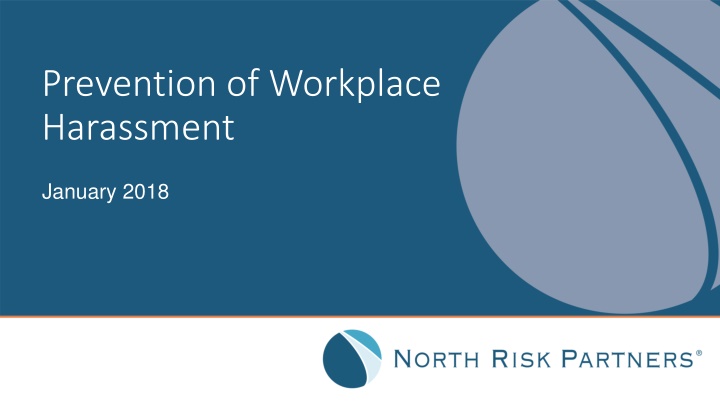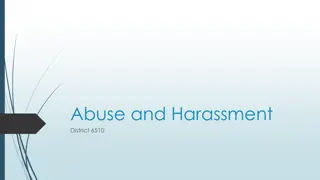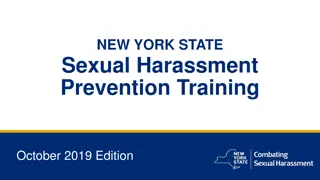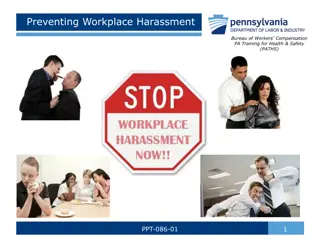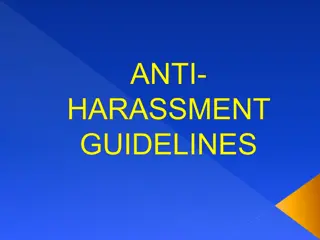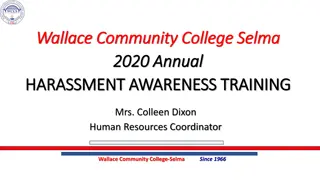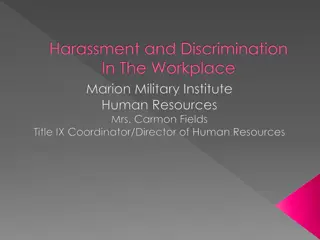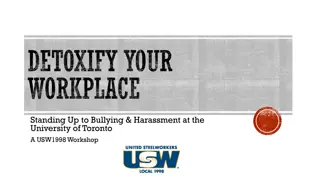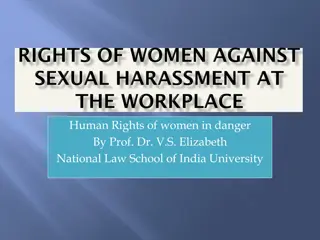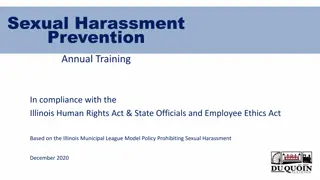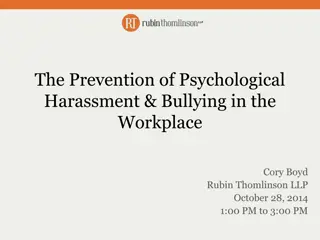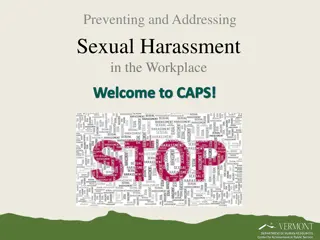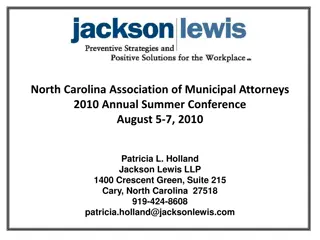Workplace Harassment Prevention Guidelines
Workplace harassment, including sexual harassment, can have significant negative impacts on employees and organizations. This article emphasizes the importance of preventing all forms of harassment in the workplace and highlights key policies and laws that address discrimination and harassment. By implementing effective prevention strategies and being aware of anti-discrimination laws, companies can create a safer and more productive work environment for all employees.
Download Presentation

Please find below an Image/Link to download the presentation.
The content on the website is provided AS IS for your information and personal use only. It may not be sold, licensed, or shared on other websites without obtaining consent from the author.If you encounter any issues during the download, it is possible that the publisher has removed the file from their server.
You are allowed to download the files provided on this website for personal or commercial use, subject to the condition that they are used lawfully. All files are the property of their respective owners.
The content on the website is provided AS IS for your information and personal use only. It may not be sold, licensed, or shared on other websites without obtaining consent from the author.
E N D
Presentation Transcript
Prevention of Workplace Harassment January 2018
Presented by: Mike Bourgon Mike Bourgon
Introduction The potential for harassment, including sexual harassment, exists in every workplace. The number of workplace harassment claims filed during recent years has increased dramatically. While some individuals may feel that harassment means only sexual harassment , it has become clear that in today s work environment the term is much broader than that. Harassment is a costly proposition for employers. It can result in: low morale, absenteeism, reduced productivity, employee turnover, and damages and litigation costs.
Company Policy: Harassment It is the policy of this Company to promote a productive work environment that is free from discrimination and harassment of any kind. To that end, the Company will not tolerate verbal or physical conduct that harasses, disrupts or interferes with another s work performance or creates an intimidating, offensive or hostile environment. It is the policy of this Company that certain rules and regulations regarding employee behavior are necessary for efficient business operations and for benefit and safety of all employees. Conduct that interferes with operations or discredits the Company or is offensive to stakeholders or staff will not be tolerated.
Harassment Prevention The Equal Employment Opportunity Commission (EEOC), in its 2001 technical assistance guidance publication: Employer EEO Responsibilities, stressed: Harassment of an individual on the basis of race, color, sex, national origin, religion, age or disability is a discriminatory practice under Title VII, the ADA and the ADEA. Although much attention has been given in recent years to sexual harassment discrimination, it is important to stress that many of the same principles apply to other types of harassment, and an employer should be equally vigilant in preventing such harassment .
Anti-Discrimination Laws Title VII of the Civil Rights Act of 1964 (Title VII): o Prohibits discrimination based on race, color, religion, sex, and national origin. o States it is unlawful to discriminate in such areas as recruitment, selection, promotion, discipline, training, etc. The Equal Pay Act of 1963 (EPA): Protects men and women who perform substantially equal work from sex-based wage discrimination. The Age Discrimination in Employment Act of 1967 (ADEA): Prohibits employment discrimination against individuals who are 40 years of age or older.
Anti-Discrimination Laws Rehabilitation Act of 1973: o Sections 501 and 505 prohibit discrimination in Federal employment against qualified individuals with disabilities. o Also requires employers provide reasonable accommodation to qualified individuals with disabilities who are employees or applicants for employment. Civil Rights of 1991: Provides rights to jury trials and monetary damages in cases of employment discrimination.
Harassment Defined Illegal harassment is severe or pervasive verbal or physical conduct that denigrates, shows hostility or aversion toward an individual because of his/her race, color, religion, gender, national origin, age, disability, or reprisal for participating in the EEO process.
Harassment Defined The EEOC defines sexual harassment as unwelcome verbal or physical conduct of a sexual nature: When submission to such conduct is made a term or condition of employment; When submission to or rejection of such conduct is used as a basis for employment decisions; When such conduct unreasonably interferes with job performance or creates an intimidating, hostile, or offensive work environment.
Important Sexual Harassment Supreme Court Case Meritor Saving Bank v. Vinson (1986) Vinson engaged in voluntary sexual relationship with supervisor; after relationship ended, she was terminated for time and attendance issues. Court held voluntary does not necessarily mean welcome. For sexual harassment to be actionable, it must be unwelcome and sufficiently severe or pervasive to alter the conditions of the victim s employment and create an abusive working environment. First recognition that hostile environment sexual harassment is actionable under Title VII.
Sexual Harassment Supreme Court Case Burlington Industries v. Ellerth and Faragher v. City of Boca Raton (1998) Ellerth quit her job - alleged supervisor made numerous threats to retaliate against her if she denied him sexual liberties. The threats were not carried out. Ellerth knew that Burlington had an anti-harassment policy but did not tell anyone in authority about the harassment. Faragher resigned as a lifeguard - alleged that her two immediate male supervisors created a sexually hostile atmosphere at work. Repeatedly subjected her and other female lifeguards to uninvited and offensive touching , lewd remarks, and speaking of women in offensive terms. Faragher failed to complain about the harassment during her employment.
Ellerth and Faragher (cont.) Principles of Cases: When sexual harassment by a supervisor results in tangible employment action against an employee, employer is automatically liable. If no tangible action taken, an affirmative defense is available, if the employer exercised reasonable care to prevent and correct promptly any sexually harassing behavior (has anti-harassment policy and complaint avenues). The employee unreasonably failed to take preventive or corrective opportunities provided by employer (failed to take advantage of complaint process).
Liability Standards for Sexual Harassment Extended to All Forms of Unlawful Harassment The U.S. Equal Employment Opportunity Commission (EEOC) adopted the principles the Supreme Court set forth in Ellerth and Faragher. Additionally, the Commission stated that while the Ellerth and Faragher decisions addressed sexual harassment, the same basic standards of liability apply to all forms of unlawful harassment.
Harassment that Results in a Tangible Employment Action A management official s harassment that results a significant change in an individual s employment status (e.g., hiring, firing, promotion, failure to promote, demotion, undesirable reassignment). Only management officials or other individuals designated to perform supervisory functions (e. g., scheduling, approving vacation, evaluating performance) can commit this type of harassment. The Company is automatically liable for this type of harassment regardless of whether upper management had knowledge of it.
Hostile Environment Harassment Comments or conduct that have the purpose or effect of unreasonably interfering with an individual s work performance or creating an intimidating or offensive working environment. This category of harassment is often more subtle than harassment that results in a tangible employment action, and is often more difficult to determine where the line falls between lawful and unlawful. The key issues here are frequency and severity. Reasonable person standard governs. Anyone can commit this type of harassment - a management official, coworker or non-employee.
Hostile Environment Harassment: Examples of Actions Pressure for dates; Making offensive remarks about looks, clothing, body parts; Touching in a way that may make an individual feel uncomfortable; Telling sexual jokes, hanging sexual posters; Using racially derogatory words, phrases, epithets; Demonstrations of a racial or ethnic nature such as the use of gestures, pictures or drawing which would offend a particular racial or ethnic group.
Hostile Environment Harassment: Examples of Actions (cont.) Comments about an individual s skin color or other racial/ethnic characteristics; Negative comments about an employee s religious beliefs; Negative stereotypes regarding an employee s birthplace or ancestry; Negative comments about an employee s age when referring to employees 40 and over; Derogatory or intimidating references to an employee s mental or physical impairment.
Harassment Complaints Key Elements Conduct must affect a term, condition, or privilege of employment. Must be unwelcome. Can be based on race, color, religion, national origin, sex, sexual orientation, age or disability. Is severe or pervasive under a reasonable person standard.
SCENARIO #1: SCENARIO #1: Evaluate This Harassment Claim Four months ago, Marcus filed an EEO complaint alleging his supervisor discriminated against him based on religion (which is now under investigation). After filing the complaint, he began to feel alienated; his co-workers started limiting their contact with him; and he believed he was not receiving any prime assignments. This week he received his performance evaluation which rated him as satisfactory. In the past three years, his rating has been twice at the highly effective level, and once at the outstanding level. His supervisor s justification for rating - He was not performing work expected of employees at his level, and he was not working well within the team.
Harassment by Co-workers, Non-employees Co-worker Harassment: The company is liable if it knew or should have known of the harassment and failed to take immediate and appropriate corrective action. Non-employees: The liability standard for non-employees is the same as for employees - Except consideration is given to the extent of the company s control over the non-employee. For example, a company may not be able to control the actions of a one-time visitor to its workplace, but it would be able to correct harassment by an independent contractor with whom it has a regular relationship.
SCENARIO #2: SCENARIO #2: Analyze the Supervisor s Response Mary dreads each time her office color photocopier breaks down because the repair person assigned to her office always leers at her and makes sexually suggestive comments. She has fears that if she complains nothing will be done about it because the company does not have control over the repair person because he is an employee of the photocopier service company. The supervisor does relay Mary s complaints to the service company, but no action is taken.
Examples of Harassing Behavior Verbal: derogatory comments, racial or sexual epithets, requests for sexual favors, sexual innuendoes, offensive jokes or stories, repeated propositioning. Non-verbal: staring, derogatory or suggestive gestures, winking, throwing kisses, shunning, and ostracizing. Visual: offensive pictures, photos, cartoons, posters calendars, magazines or objects. Physical: unwelcome touching, hugging, kissing, patting, stroking, standing too close. Written: unwelcome personal letters, notes or emails.
Recognizing Harassment The conduct must be unwelcome to the target of the harassment. Unwelcome means that the employee did not solicit or incite the conduct and regarded it as undesirable. The harasser can be the victim s supervisor, an agent of the employer, a supervisor in another area, a co-worker, or a non-employee. Harassment can be verbal, physical, or pictorial. The harasser as well as the target can be a man or woman. Claimant does not have to be the person at whom the offensive conduct is directed but can be anyone affected by the conduct.
Harassment Prevention: Employees Responsibilities Employees are expected to maintain a productive environment that is free from harassing or disruptive activity. No form of harassment will be tolerated, including harassment for the following reasons: race, color, national origin, religion, sex, sexual orientation, disability or age. Any employee who believes that he/she is victim of unwelcome harassment has the responsibility to report or file a complaint about the situation as soon as possible. The report or complaint should be made to the employee s supervisor; or Senior Management if the complaint involves the supervisor or manager.
Preventing Sexual Harassment Employees should: Avoid behavior that may be misconstrued as possible sexual harassment. Avoid sexual jokes, comments, and emails. Respect a person s indication that your conduct or attention is not welcome. Not invade another individual s personal space. Not touch anyone without their permission. Clearly inform those engaging in inappropriate sexual orientated behavior that they find it objectionable. Seek assistance promptly if they are the target of or observe severe or repeated instances of behavior that they believe qualify as sexual harassment.
What Should a Victim of Harassment Do? A victim of harassment should clearly communicate to the harasser verbally, in writing, through a third party, or in some other way that the conduct is unwelcome. Evidence that the victim participated in the conduct that she or he later challenged would generally defeat a harassment claim since participation communicates welcomeness. However, participation does not necessarily mean the conduct is welcome. In particular, acquiescence or submission to sexual demands does not necessarily mean that the conduct was welcome. The victim or person affected by the conduct should promptly report it or file a complaint if the conduct continues after the perpetrator becomes aware it is unwelcome.
Harassment Prevention: Supervisors Responsibilities Monitor workplace behavior, enforce respect. Treat all complaints seriously and confidentially. Do not ignore any allegation. Post/disseminate EEO Policy. Respond to allegations immediately; investigate, as appropriate. Be sensitive but impartial. Interview parties and relevant witnesses. Ask open-ended questions. Collect relevant documentation/evidence. Take appropriate corrective action, follow-up. Ensure no retaliation. Document your actions.
Investigation of Harassment All complaints will be investigated promptly - in as impartial and confidential a manner as possible. Employees are required to cooperate in any investigation. A timely resolution of each complaint should be reached and communicated to the parties involved. Any employee, supervisor, or manager who is found to have violated the harassment policy will be subjected to appropriate disciplinary action, up to and including termination. The Company prohibits any form of harassment for bringing bona fide complaints or providing information on harassment.
Case Studies These case studies present hypothetical situations that will test your understanding of workplace harassment, and allow you and share your perceptions and observations with others.
Case Study #1 Bill sometimes makes comments to his administrative assistant, Ann Smith, about how attractive she is. She never says anything when he makes these comments. One day, Ann requests a raise. Bill says that he will consider her requests, and suggests that the two of them go for drinks and to dinner after work. Ann makes it clear that she wants to keep their relationship purely professional and would therefore prefer not to go out with him. Bill says that he understands. Two weeks later, Bill informs Ann that he has denied her request for a raise. She asks Bill for an explanation, and he says that if she would be more cooperative with him, then her chance for a raise would improve. Ann asks what does cooperative means. Bill smiles and says You figure it out .
Case Study #2 William keeps a large bible on his desk at work and always wears a large silver cross around his neck. At times William will use biblical quotations to support his comments and assertions that his observations are correct in conversations with his co-workers. Additionally, he usually tells people to have a Blessed Day . Joe, one of William s co-workers, has started referring to him as Saint Willy . This has gotten a lot of laughs around the office. William has confronted Joe about this and asked him to stop. Joe response was can t you take a joke . Joe not only has not stopped referring to William as Saint Willy , but he has encouraged others to do so.
Case Study #3 Pam, an attractive female employee, likes to wear blouses with a plunging neckline, short tight skirts and high heels. When she walks down the hall in the office, many times her male co-workers and some females stare at her, some with a knowing smile, others just shake their heads. Occasionally, one individual silently acts as if he is having a heart attack. She has repeatedly indicated to her co-workers that their conduct embarrasses her, and has asked them to stop, but without much success. Some of her female co- workers have mentioned that she causes her problems by the way she dresses.
Synergy HR Hotline Contact Information Mike Bourgon Employment and Labor Law Attorney, HR Consultant hotline@synhr.com (888) 603-7872 Michael Conroy HR Consultant
